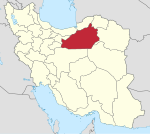Tarikhaneh Mosque
Etymology
"Tarikhaneh" is derived from tari ("god") and khaneh ("home"), thus meaning "god's home".
History
The chronology of the building's construction is not well-documented. Scholarly discourse regarding the mosque's construction date has produced varied conclusions. Notably, historian Mohammad Karim Pirnia dates the original building's construction to around 150 AH (767-768 CE) based on architectural styles and historical context. Other sources suggest that while no definitive inscriptions exist to confirm its age, the mosque likely predates 200 AH (815-816 CE) due to its stylistic features. Based on its very close similarities with earlier Sasanian architecture, it is likely from the first centuries of Islamic rule, possibly the 8th century. Some scholars have suggested that its overall form and style corresponds more to the 9th century. The mosque exemplifies the architectural transition during the Islamic period, influenced by the significant cultural and religious shifts that occurred following the advent of Islam in the Iranian plateau. The introduction of Islam initiated profound changes in the region's religious, cultural, and social life, transforming pre-Islamic practices that had been dominated by Zoroastrianism and other faiths. Tarikhaneh Mosque's enduring legacy is not only rooted in its architectural merit but also in its representation of the historical convergence of cultures and religions in Iran, showcasing the rich tapestry of Islamic architecture's evolution in response to regional characteristics and historical contexts.
Architecture
The main plan consists of a square courtyard which is surrounded by arcades of barrel vaults supported by slightly pointed fired brick arches set on thick circular pillars, typical of Sassanid architecture. The pillars are 3.5 meters (11.5 feet) tall and almost 2 meters (6 feet) in diameter. The hypostyle prayer hall consists of several naves or aisles divided by arcades and covered by vaults, with the central nave being larger than the others. According to Pope, "It expresses dignity and confidence, but also humility."
Standing together at a distance from the mosque are the remains of a square column of uncertain date, possibly part of the original construction period and a cylindrical minaret. The latter was built sometime in the years 1026 to 1028. It resembles the style of later Seljuk minarets. The minaret is 4.2 meters in diameter; its top has fallen, but originally must have measured more the 30 meters high, with a gallery supported on muqarnas corbels. The tower is strikingly divided into six zones of ornamentation, each rendered in brick with a different geometric pattern. An inscription at around mid-way up the tower records that its construction was commissioned by the local governor, Abu Harb Bakhtyar ibn Muhammad.

-
View from the courtyard to the prayer hall
-
Columns and arches of the prayer hall
-
Vault over the central nave of the prayer hall
-
The minaret
References
- ^ Pope, Arthur Upham (1965). Persian Architecture. United States of America: Thames and Hudson. pp. 78–80, 89, 100.
{{cite book}}: CS1 maint: date and year (link) - ^ "Iranian Architecture ✅ History & Types | Destination Iran". 2010-03-20. Retrieved 2025-01-06.
- ^ "Tarikhaneh Mosque: A Masterpiece of Iranian Ancient Architecture". EavarTravel. 2024-08-16. Retrieved 2025-01-06.
- ^ Montashery, Mehran (2019-01-01). "The Development of Bricks Ornamentation from the early Islamic Centuries to the End of Kharazmshahian Period in the Architecture of Mosques in Iran". International Journal of Architecture and Urban Development.
- ^ Hillenbrand, Robert (1994). Islamic Architecture: Form, Function and Meaning. Great Britain: Columbia University Press. pp. 34, 46, 77, 101–2, 487. ISBN 0-231-10132-5.
{{cite book}}: CS1 maint: date and year (link) - ^ Azad, Mitra (2013-10-23). "Continuation of Sassanid Religious Architecture in Trikhaneh Mosque, Damghan". Soffeh. 23 (2): 85–104. ISSN 1683-870X.
- ^ Damghan Tarikhane Mosque. Tarikhaneh: Miras Semnan.
- ^ Blair, Sheila; Bloom, Jonathan M. (2011). "Iraq, Iran, and Egypt: the Abbasids". In Hattstein, Markus; Delius, Peter (eds.). Islam: Art and Architecture. h.f.ullmann. p. 110. ISBN 9783848003808.
- ^ M. Bloom, Jonathan; S. Blair, Sheila, eds. (2009). "Architecture; IV. c. 750–c. 900". The Grove Encyclopedia of Islamic Art and Architecture. Vol. 1. Oxford University Press. p. 82. ISBN 9780195309911.
- ^ Kuban, Doğan (1974). The Mosque and Its Early Development. Brill. p. 22. ISBN 978-90-04-03813-4.
- ^ Adle, Chahryar (2011) [1993]. "DĀMḠĀN". Encyclopaedia Iranica (Online). Retrieved 2023-08-03.
- ^ Studies, Iranian Journal Archaeological (2022-01-01). "Orientation Towards Qibla in Iranian Mosques: The Confrontation of Elements". Iranian Journal of Archaeological Studies (IJAS).
- ^ Emami, Farshid (2021-01-01). "Religious Architecture of Safavid Iran". The Religious Architecture of Islam, Volume I, eds. Hasan-Uddin Khan and Kathryn Blair Moore.
- ^ Goode, Patrick (2009). The Oxford Companion to Architecture. Oxford University Press. p. 467. ISBN 978-0-19-860568-3.
- ^ O'Kane, Bernard (1995). Studies in Persian Art and Architecture. The American University in Cairo Press. pp. 207–210. ISBN 978-977-424-370-7.
- ^ Blair, Sheila (1991). The monumental inscriptions from early Islamic Iran and Transoxiana. Brill Academic Publishers. p. 96. ISBN 978-90-04-09367-6.
- ^ Hattstein, Markus; Delius, Peter, eds. (2011). Islam: Art and Architecture. h.f.ullmann. p. 110. ISBN 9783848003808.
External links
![]() Media related to Tarikhaneh at Wikimedia Commons
Media related to Tarikhaneh at Wikimedia Commons





